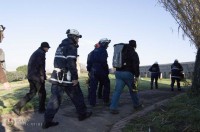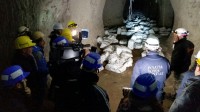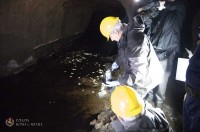 Roman police have discovered tons of refuse, everything from household trash to industrial waste, illegally dumped in the 2nd and 3rd century A.D. catacombs of Tor Fiscale, an archaeological park in east Rome. Situated on the Via Latina near the junction with the ancient Appian Way, the Tor Fiscale park is part of the vast Appian Way Regional Park. The small park is dense with archaeological riches. It is at the crossroads of six Roman and one Renaissance aqueduct whose arched galleries dominate the landscape alongside the 13th century tower that gives the park its name. It is replete with remains of ancient luxury villas, homes, tombs and underground caves dug out of soft volcanic tufa. Initially carved to quarry the stone, the caves were used by early Christians for gatherings and burials during the imperial era when the religion was viewed with suspicion and its adherents sometimes persecuted.
Roman police have discovered tons of refuse, everything from household trash to industrial waste, illegally dumped in the 2nd and 3rd century A.D. catacombs of Tor Fiscale, an archaeological park in east Rome. Situated on the Via Latina near the junction with the ancient Appian Way, the Tor Fiscale park is part of the vast Appian Way Regional Park. The small park is dense with archaeological riches. It is at the crossroads of six Roman and one Renaissance aqueduct whose arched galleries dominate the landscape alongside the 13th century tower that gives the park its name. It is replete with remains of ancient luxury villas, homes, tombs and underground caves dug out of soft volcanic tufa. Initially carved to quarry the stone, the caves were used by early Christians for gatherings and burials during the imperial era when the religion was viewed with suspicion and its adherents sometimes persecuted.
 Authorities came to suspect something was rotten underground during an investigation of illegal car scrapyards and waste disposal rackets in the area. On January 26th, about 20 people — police officers, personnel from Italy’s Regional Environmental Protection Agency (ARPA), municipal workers and members of the archaeological speleology organization Sotterranei di Roma (Undergrounds of Rome) — worked together to explore miles of the underground tunnels. They found a shocking amount of waste, including old refrigerators, mattresses, electronics, tires, batteries, hundreds of bags of organic materials full of various molds that may have been used in the cultivation of mushrooms.
Authorities came to suspect something was rotten underground during an investigation of illegal car scrapyards and waste disposal rackets in the area. On January 26th, about 20 people — police officers, personnel from Italy’s Regional Environmental Protection Agency (ARPA), municipal workers and members of the archaeological speleology organization Sotterranei di Roma (Undergrounds of Rome) — worked together to explore miles of the underground tunnels. They found a shocking amount of waste, including old refrigerators, mattresses, electronics, tires, batteries, hundreds of bags of organic materials full of various molds that may have been used in the cultivation of mushrooms.
 In one of the deepest tunnels, they found a veritable lake of greasy black goo that is likely used motor oil. On the surface alone this lake of hydrocarbon pollution covers about 200 square meters (2,150 square feet), and preliminary analysis found the lake is more than a foot deep, so the total volume of toxic filth in this one spot alone is something in the neighborhood of 800 cubic meters (28,250 cubic feet). At some points the vaults of the tunnel appear to be impregnated with the goop, suggesting it was dumped from above rather than transported deep into the caves. The team took samples of the fluid to identify it and they will examine the surface to locate the entry point. There will also be extensive testing to assess whether the oil has seeped into the water table.
In one of the deepest tunnels, they found a veritable lake of greasy black goo that is likely used motor oil. On the surface alone this lake of hydrocarbon pollution covers about 200 square meters (2,150 square feet), and preliminary analysis found the lake is more than a foot deep, so the total volume of toxic filth in this one spot alone is something in the neighborhood of 800 cubic meters (28,250 cubic feet). At some points the vaults of the tunnel appear to be impregnated with the goop, suggesting it was dumped from above rather than transported deep into the caves. The team took samples of the fluid to identify it and they will examine the surface to locate the entry point. There will also be extensive testing to assess whether the oil has seeped into the water table.
After making the shocking discovery, police used drones to fully explore the network of bat-and-mice-infested tunnels to try to establish the extent of the dumping.
It is thought that local businesses and residents have been using the site to cheaply dispose of their unwanted goods for years. Police even discovered that unscrupulous dumpers had drilled shafts down into the caves from above, which they used as rubbish chutes to quickly dispose of their unwanted goods.
Authorities have closed the entrances to the caves on Via Demetriade and Via di Torre Branca, but of course that won’t stop people from using their homemade garbage chutes. The municipal police are investigating the case in the hopes of finding who is responsible, at least most recently, for this ruthless assault on Rome’s cultural history and environmental health.